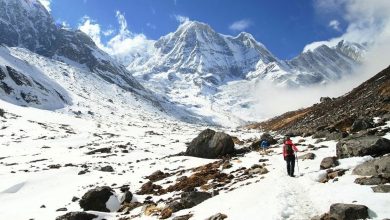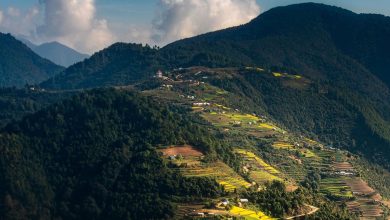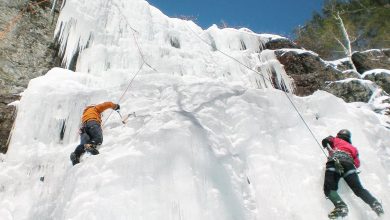Dhaulagiri Mountain 8167m / 26795ft – 7th Hightest Mountain
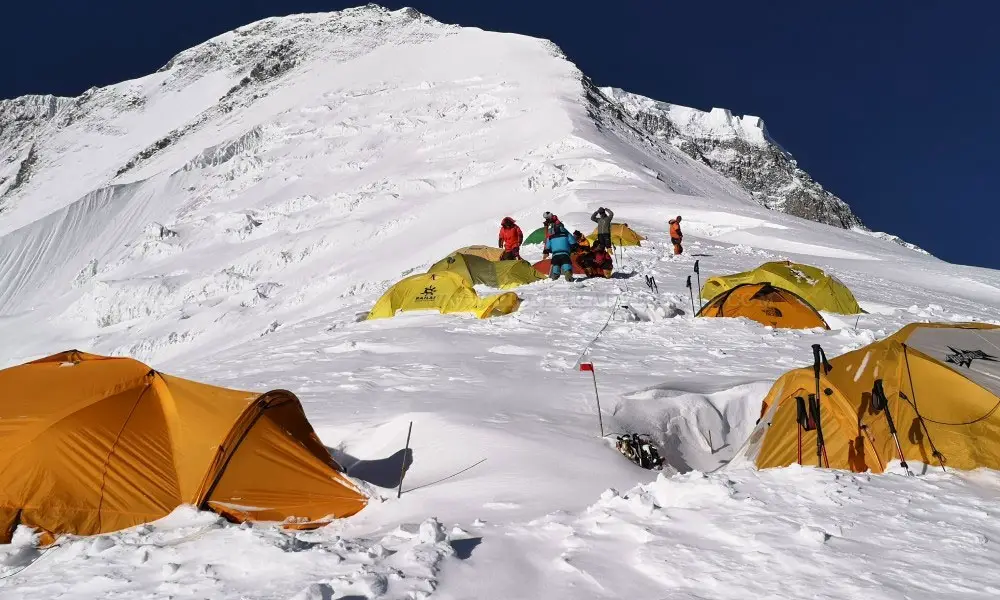
Dhaulagiri is the seventh-highest peak in the world. It is one of the 14 tallest peaks above a height of 8000 meters. And it is located in Nepal. It stands 8,167 meters (26,795 ft) above sea level. The mountain is also the highest end of the Gandaki River basin. The first people to climb this mountain were the members of the Swiss-Austrian-Nepali expedition in the year 1960. The mountain is one among the Himalayan massifs of the west-central part of Nepal.
Dhaulagiri I, Dhaulagiri II, Dhaulagiri III, and Dhaulagiri IV all go above the height of 25,000 feet (7,620 meters). Among these, the tallest, which is Dhaulagiri I, is the one declared the seventh tallest mountain in the whole world. One of the most fascinating facts about this mountain is that all of its peaks lie within the border of Nepal. Dhaulagiri is one of the most sought tourist sights and is very often visited when tourists are around Pokhara, which is south of the Annapurnas, lying east of Dhaulagiri at a distance of 8,091 m (26,545 ft) is 34 km (21 mi).
In this article, we have summarized everything you might be curious about Dhaulagiri Mountain. Stay tuned till the end to know more!
Why is Dhaulagiri famous?
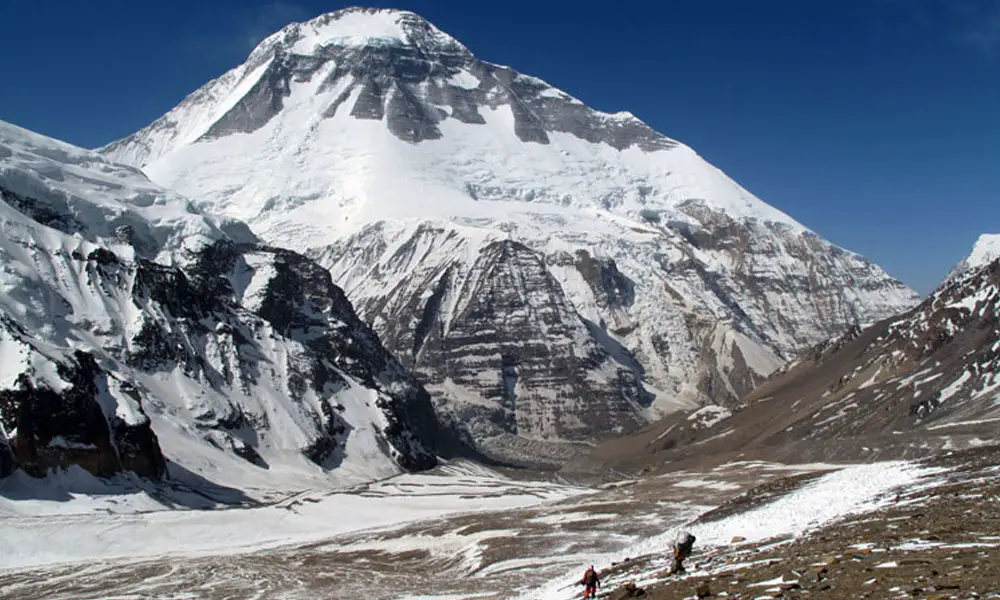
Dhaulagiri is the seventh-highest peak in the world. It is 8167 meters tall. Hence, it has been declared one of the 14 peaks, or the 8000-ers. Many mountaineers come to this peak for an expedition every year. The most popular among all the other Dhaulagiri peaks has to be Dhaulagiri I, which is also the highest among the others. Moreover, it also lies northwest of Pokhara, Nepal’s tourist center. Hence, Dhaulagiri mountain is a sight of fascination even to those visiting the city side of Pokhara.
Dhaulagiri was not ascended all that easily, though. There were several attempts to summit the mountain in the years 1950-1959, which were made by climbers from Swiss, French, Argentine, and Austrian expeditions. But, the only team to finally succeed was the Swiss-Austrian-Nepali team in 1960, almost after a decade of remaining unsuccessful in the climb. The victorious team was led by Max Eiselin.
A lesser-known fact about this mountain is that it was considered the tallest mountain in the world until 1808. Likewise, mountaineer Fredrick Ericcson was willing to make the first ski descent from Dhaulagiri in the year 2008. Still, the awful and dangerous conditions of the mountains made him change his decision. And he backed off from 8000m (26,250ft), which was a little below the mountain’s peak. However, he made an upward ski descent from 3000m (9842ft).
Likewise, many mountaineers have attempted, succeeded, as well as failed in their attempt to summit or experiment in the Dhaulagiri mountain. It is especially recognized as one of the eight-thousanders, which is also quite difficult to ascend.
How did Dhaulagiri get its name?
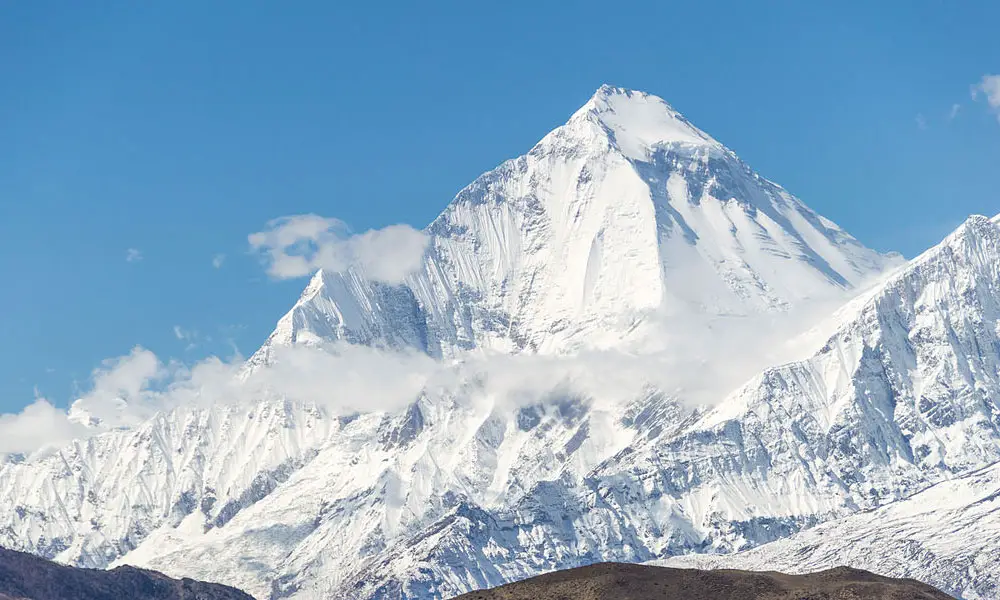
Mount Dhaulagiri got its name from the Sanskrit word “dhawala,” the synonym for beautiful, dazzling, and white collectively to another word, Giri, which means mountain.
Where is Dhaulagiri Mountain located?
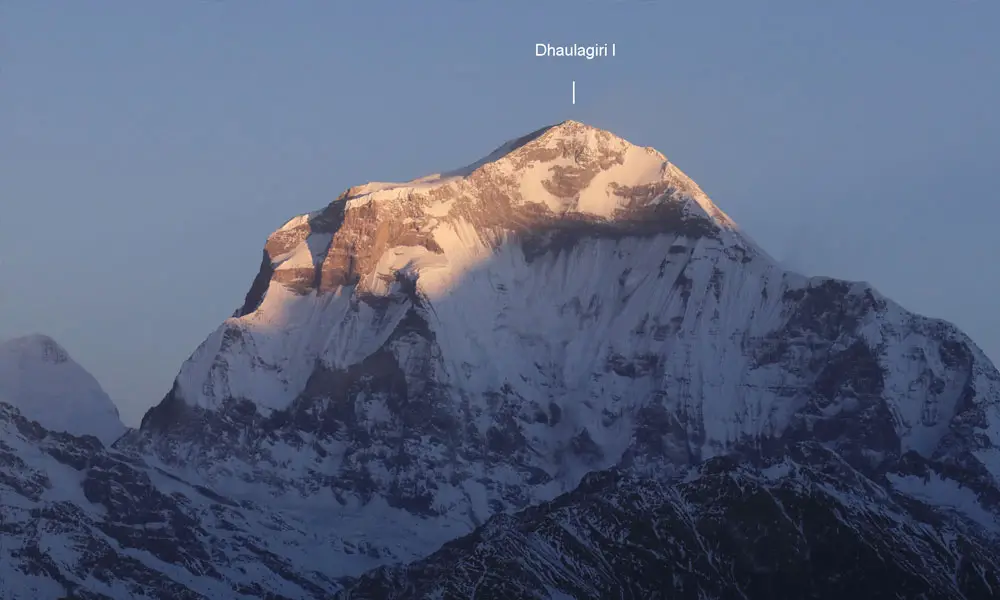
Dhaulagiri Mountain is located in the northwest part of Pokhara, Nepal, in the Myagdi district. The highest of this peak, Dhaulagiri I, is situated on the border of Dhaulagiri and Raghuganga rural municipalities. It is in Nepal’s Gandaki Province. Dhaulagiri I stands 8.4 km south-southwest of Tukuche Peak and 6.7 km north-northeast of Manapathi.
Dhaulagiri II is approximately 12.5 km to the north-northwest of Dhaulagiri I, whereas Sita Chuchura is 9.6 km to the north. Similarly, the mountain range in which it is located is known as the Dhaulagiri mountain range.
Can you see Dhaulagiri from Pokhara?
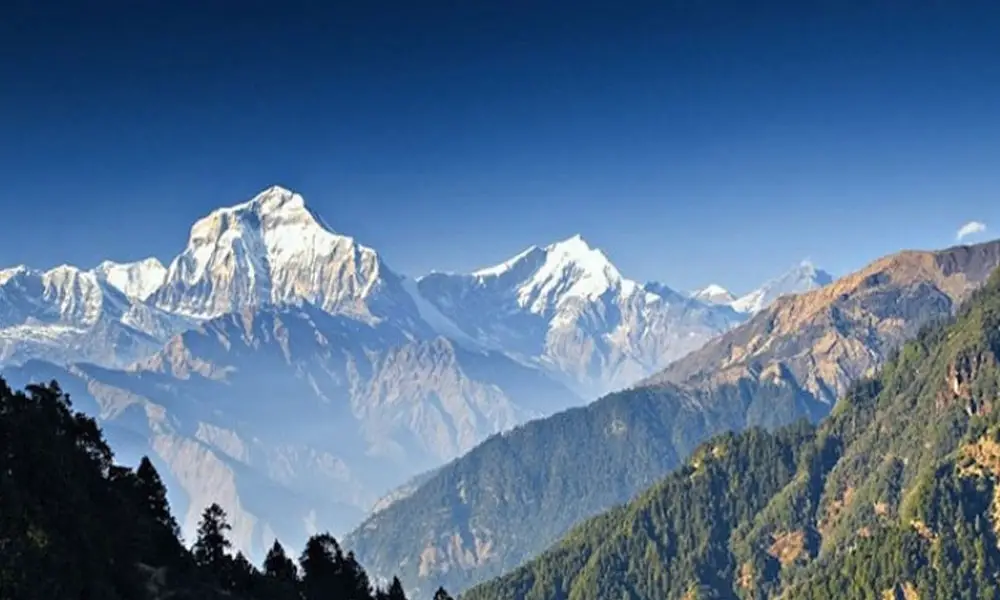
Dhaulagiri mountain lies only a few kilometers to the northwest of Pokhara. Hence, you will get a beautiful view of the mountain when you are there. Furthermore, Pokhara and Dhaulagiri are both in Gandaki, which makes it obvious that the small distance will come to your favor even when you don’t climb the mountain but want to get a nice view of it.
Who has climbed Dhaulagiri mountain?
A lot of mountaineers, throughout the decades, have majorly made an attempt to climb Dhaulagiri from the northeast ridge route, but this does not generalize to all climbers. Many have made started their climbs from all the other sides of the mountains as well.
There were 358 successful summits and 58 deaths in the mountain till 2007. And the fatality rate of this mountain is 16.2%. On Dhaulagiri I, 2.8% of the 2,016 expedition travelers and members who ventured above base camp died between 1950 and 2006 hence proving the ruthless nature of the mountain. There have been several ascents of Mount Dhaulagiri since the earliest recorded year of 1950, which happened to be the French expedition led by Maurice Herzog. Climbing and actually summiting the mountain were all about trial and error until 1960. A whole decade of attempts finally proved to be fruitful when on May 13, the Swiss-Austrian expedition under the supervision of Max Eiselin resulted in the successful ascent of Kurt Diemberger, Peter Diener, Ernst Forrer, Albin Schelbert, Nyima Dorje Sherpa, and Nawang Dorje Sherpa.
Ever since, many have attempted to climb the mountain, till a record of the year 1999. In the attempt of 1999, British summiteer Ginette Harrison perished in the mountain in October. Slovenian Tomaž Humar made an attempt the same year but had to return from 7,300 m due to a 300m rock on the way. The south face of Dhaulagiri remains unclimbed to this day.
What is Dhaulagiri known as?
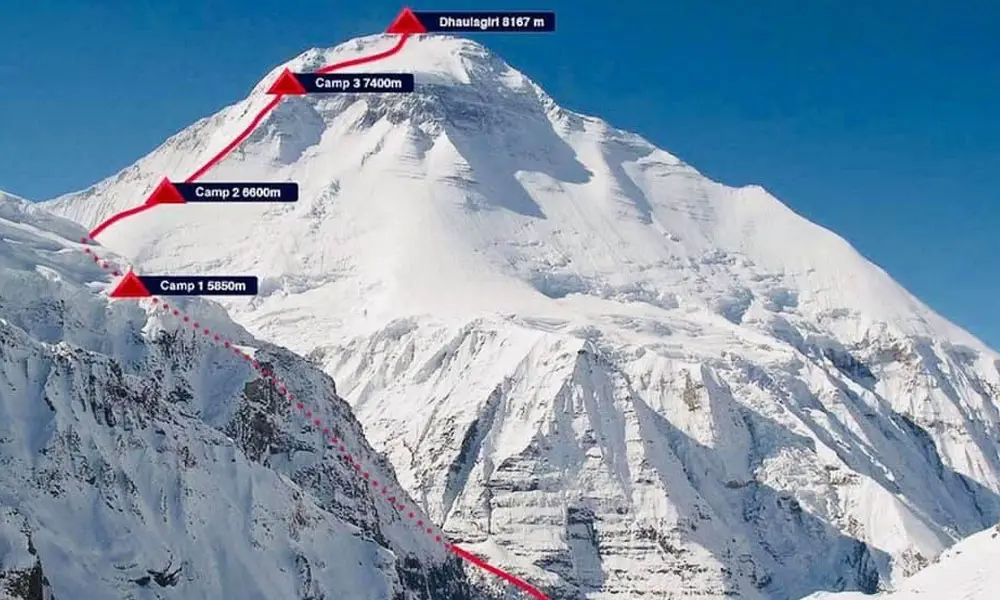
Mount Dhaulagiri is known as “ White Mountain,” given the fact that it has always been tall, mighty, and snow-clad. The white snow, from a distance, looked nothing short of a white and beautiful gift from nature. Hence, a Sanskrit word meaning the same was the reason behind the name Dhaula giri.
When was Dhaulagiri discovered?
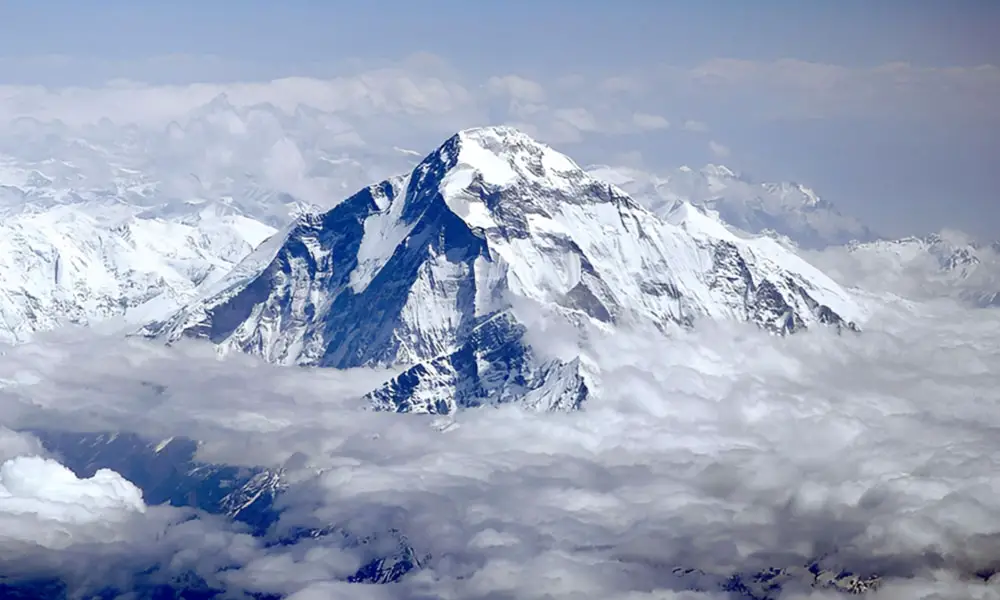
Dhaulagiri I, which happens to be the tallest out of all the other Dhaulagiri peaks, was discovered in 1808. In the year that it was discovered, it was considered the tallest peak in the world. But, it was not so. The claims of it being the tallest mountain in the world were later dismissed when the heights of the other three taller mountains, i.e., Mt. Everest, K2, Kanchenjunga, Lhotse, Makalu, and Cho Oyu, were measured.
However, after its discovery, it remained the highest peak for 30 years. The tallest peak of Dhaulagiri is located on the border of Raghuganga rural municipality of Myagdi District and Dhaulagiri.
Who is the first woman to climb Dhaulagiri?

Dhaulagiri has been ascending for many years since 1960. However, all the expeditions were conducted by men and succeeded by them only. It was much later, in October 2021, that the first two women became successful in climbing the seventh-highest peak in the world for the first time. It was Purnima Shrestha and Pasang Lhamu Sherpa Akita, who was also the first female mountain instructor and Sherpa guide.
Five mountains in Dhaulagiri
Dhaulagiri is not just a sole mountain, but collectively five mountains in the Dhaulagiri range, namely Dhaulagiri I, Dhaulagiri II, Dhaulagiri III, Dhaulagiri IV, and Dhaulagiri V. Expeditions to all five of these peaks is going to take you a trip to Kathmandu to Pokhara, and then a route from the caravan to finally the climb of the mountains.
Dhaulagiri I

Dhaulagiri I is unlike the White Mountain, which is situated on the border of Raghuganga rural municipality of Myagdi District and Dhaulagiri. It is what made Dhaulagiri the seventh tallest mountain in the world. Hence, this is the tallest of the five other peaks in the mountain range.
Dhaulagiri II
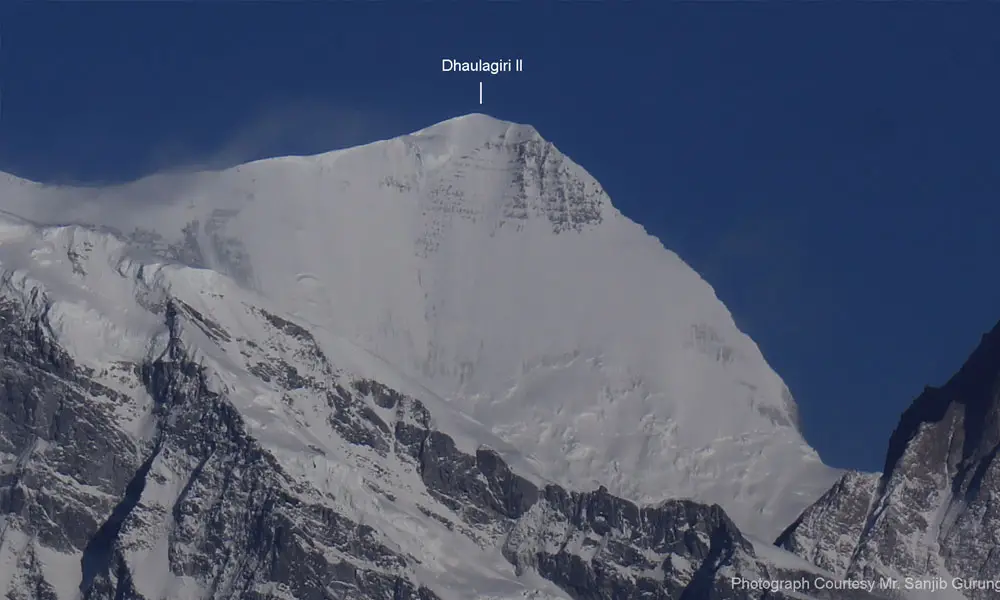
Likewise, Dhaulagiri II is located on the border of Chharka Tangsong Rural Municipality, Dolpa, and Dhaulagiri Rural Municipality, Myagdi, in Gandaki Province. It stands tall at a height of 7,751 meters (25,430 ft) above sea level. It is the second-highest peak among the five mountains in Dhaulagiri. While Dhaulagiri I is among the eight-thousanders, Dhaulagiri II is one among the seven thousanders peak that remained unclimbed until 18 May 1971, when the Austrian-American expedition team, including Adolf Huber, Ronald Fear, Adi Weissensteiner, and Jangbu Sherpa summited the mountain from the northwest side.
Dhaulagiri III
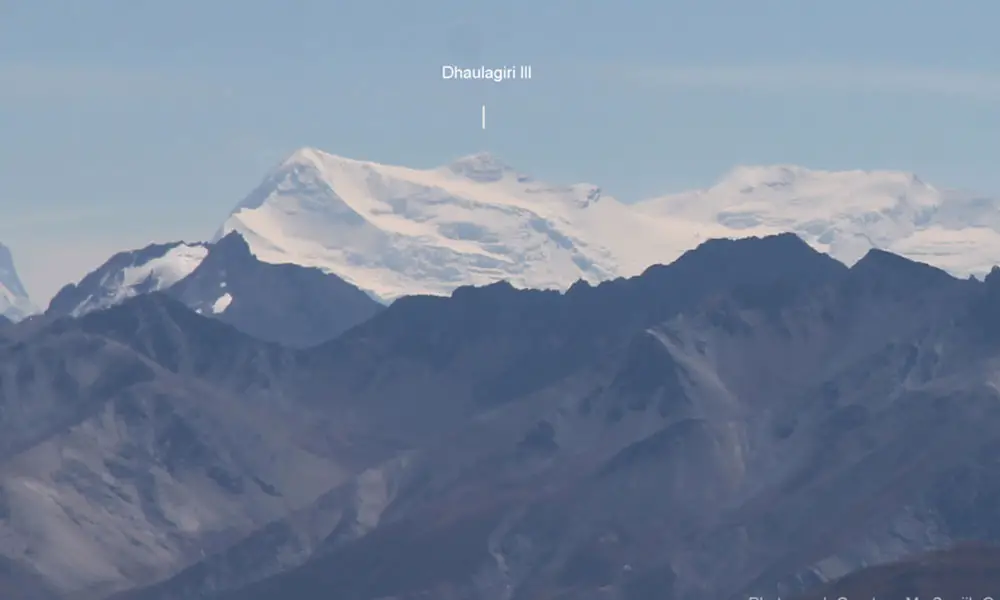
Dhaulagiri III is the third tallest peak among the five peaks in the Dhaulagiri mountain range. It stands tall at a height of 7715 meters(25,312 ft). It is located in the Chharka Tongsong/Dhawalagiri municipality in Dolpa/Myagdi district. It remained an unclimbed seven thousand until 1973 when it was finally expedited by Gerhard Haberl, Hans Saler, Klaus Süssmilch, Peter von Gizycki, Konrad Hiller, Bernd Schreckenbach, and Klaus Schreckenbach. While the mountain is still much shorter in height than Dhaulagiri I, it has been considered one of the hardest peaks to summit by Klaus in one of his articles that he wrote after the success of the ascent. He also mentioned that all camps were struck by the first of November that year. His team made the expedition in September.
Dhaulagiri IV
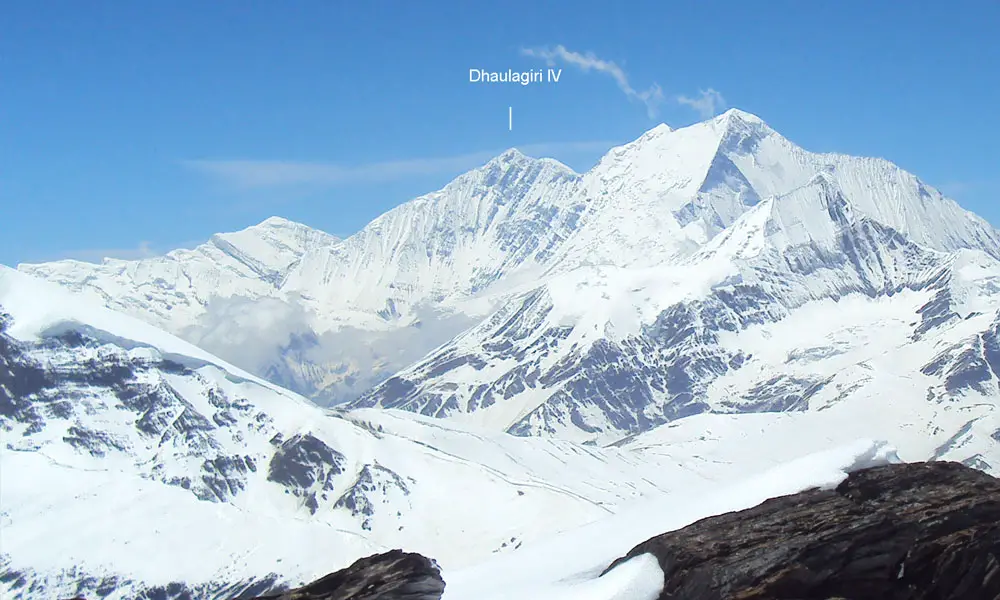
Dhaulagiri IV is the fourth tallest mountain among the five. It stands at a height of 7,661m (25,135ft) above sea level. It is located in Chharka Tongsong/Dhawalagiri in Myagdi district as well. Shiro Kawazu and Etsuro Yasuda made the first ascent of this peak on May 09, 1975.
Dhaulagiri V
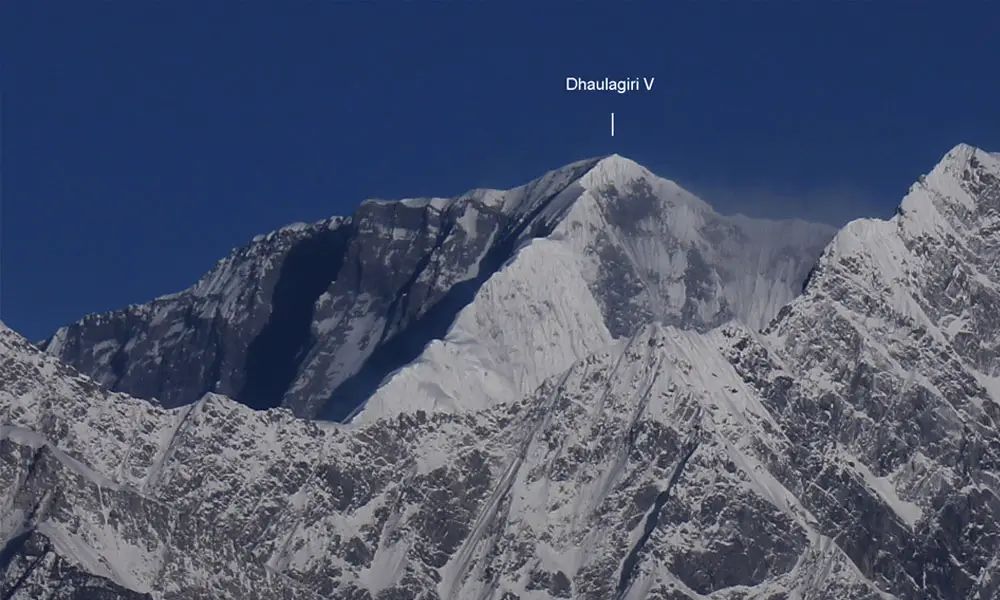
Dhaulagiri V is, by its name, the fifth-highest mountain in the Dhaulagiri mountain range. The height of this peak is 7,618m(24,992 ft) above sea level. This peak, just like all the other peaks from the Dhaulagiri mountain range, remained unclimbed till May 01, 1975. The first expedition to this mountain was made and summited by Masaaki Morioka and Pemba Tsering Sherpa.
How many people have climbed Dhaulagiri?
Around 550 people climbed Dhaulagiri in a record the first 63 years of the first climb. Similarly, in the spring of 2022, there was a new record of about 647 mountaineers who had actually been successful in summiting the tallest Dhaulagiri I.
Is Dhaulagiri easy to climb?
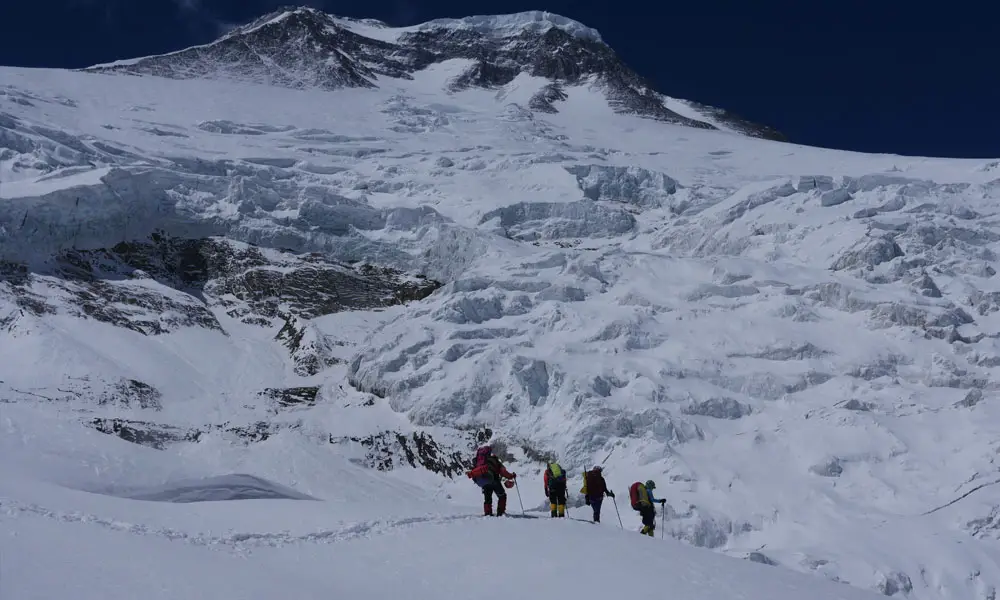
Dhaulagiri is not the easiest mountain to climb, given the fact that the tallest mountain in its range is above the height of eight thousand. Likewise, other peaks of the mountain range had been unclimbed for the longest time, which kind of proves the point as to why Dhaulagiri is not the easiest to climb.
The mountain is climbed with 3 camps which all lie above the base camp. And the routes are difficult regardless of the claims of it being an easier mountain to climb. Climbers have been losing their lives in the mountain for years. Hence, it really would not be wise for potential climbers to overestimate their own success based on past success rates while underestimating the fatality rate on the mountain.
As you go above the Death Zone, chances are, you will not make it to the peak if you do not have the gears, equipment, expertise, or guidance that you are more than likely required to have. The high altitude will suffocate the mountaineers, and there is just as equal a chance that the weather conditions, or simply the bad conditions of the mountains, will push you to an unwanted accident.
What is the best time to go to Dhaulagiri?
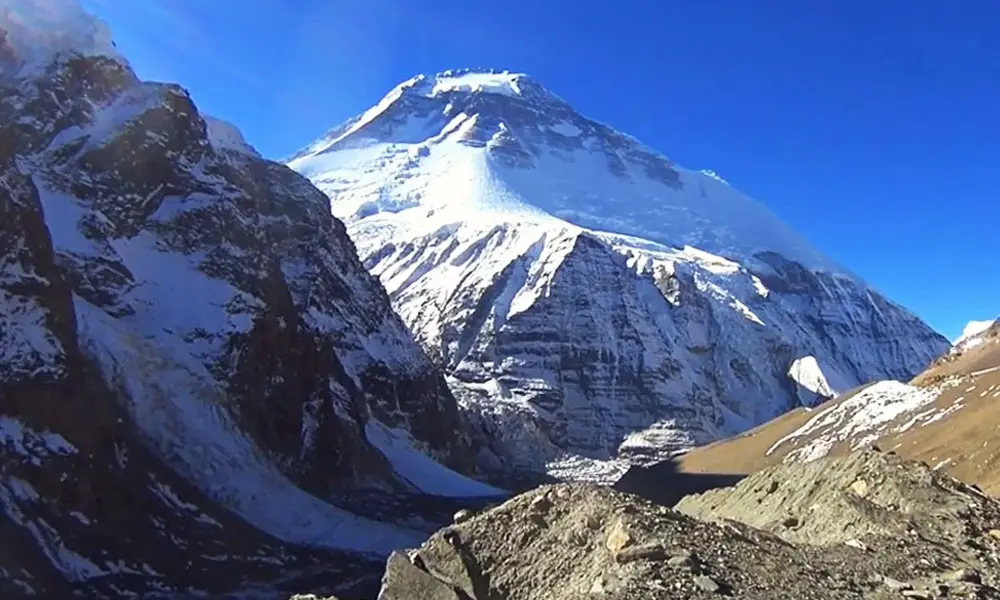
Dhaulagiri is definitely a mountain that should be climbed mostly only during either spring or autumn. When you climb the mountain in seasons besides those mentioned before, you are likely to have a hard time.
Winters, November to February, is the coldest in Dhaulagiri. Hence, it is not suggested that you climb the mountain during these seasons. Winter is also an off-season for trekking. Hence you won’t see a lot of mountaineers around the area during this season. However, when you trek to the mountain in months like September, October, and the earliest of November, you will likely find more expeditors climbing the mountain. This is not an off-season, and the success rates for climbers climbing during these months are quite high. Therefore, if you want the best mountaineering experience, you can simplify your climb and go during autumn.
Or, the spring season, with months like June, July, and August, can prove to be fatal for many climbers as the lower routes are likely to experience rainfall. Rainfall is also a cause of excessive ice falls, accidents, landslides, and floods in the Dhaulagiri area. While a climber can be cautious, if he is not a botanist or there for scientific experiences, he can wait until it is autumn to make his expedition finally.
Therefore, winter and spring can actually not be safe, while autumn is the preferable season to go to Dhaulagiri for an expedition or trekking.
Dhaulagiri Circuit Trek Difficulties
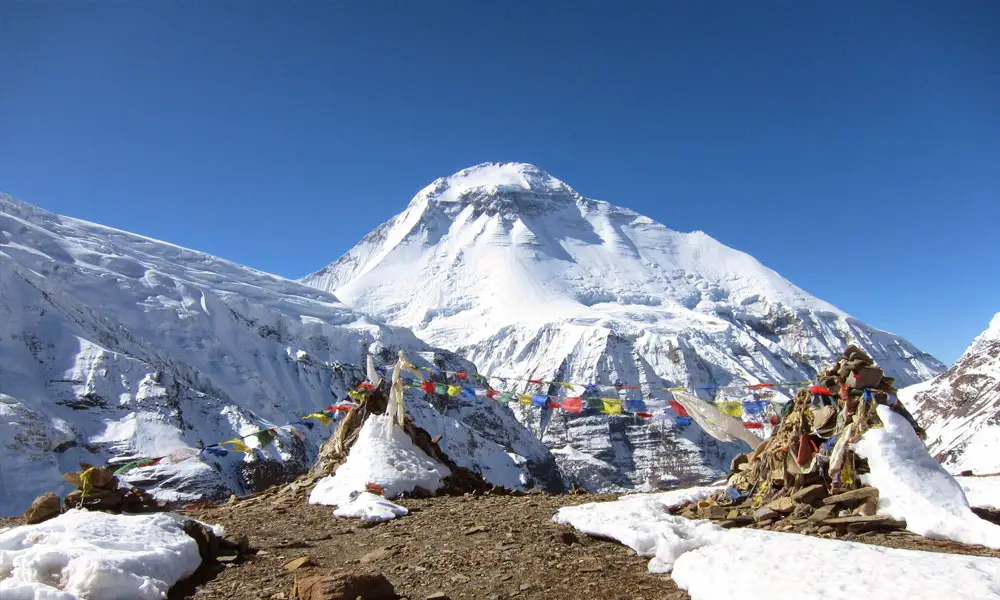
There are several reasons why the Dhaulagiri Circuit trek will prove to be difficult for trekkers. And some of the major reasons are:
Altitude sickness
Acute mountain sickness or altitude sickness is quite common when mountaineers go above the height of even 4000m. Hence, Dhaulagiri is not an exception. While it is necessary that mountain climbers take along necessary supplies and precautions before they even do the climb, they are still likely to suffer from nausea, vomiting, difficulty in sleeping, dizziness, challenges in breathing and walking straight,
Challenging routes
Routes in Dhaulagiri comes under medium to advanced level of difficulty. The off-beaten roads and the rural nature of the paths taken on the way up to the mountain will be nothing short of challenging. The travelers who are experienced will suffer less than a mountain climber who has only climbed shorter mountains. Rural roads are not the best for a beginner. Hence, challenging routes add up to the difficulties of the Dhaulagiri Circuit trek.
Bad weather
Weather conditions in Dhaulagiri really cannot be trusted. The trails may get difficult with windy and unforeseen rain or extreme cold. Hence, bad weather will lead you to suffer whilst making it up to the top.
The physical condition of the climber
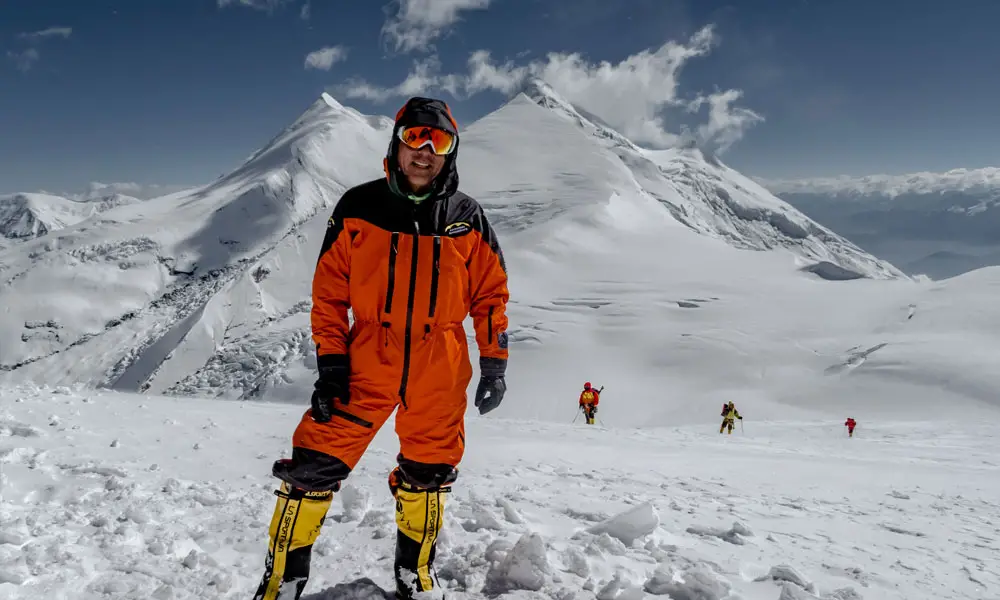
While every mountaineer should be physically fit, a mediocre physical state really cannot help you summit the mountain. You either have to be used to walking for 6 to 8 hours straight in the most rural possible paths, or you will end up in an accident or simply fail to summit the mountain. Additional prior experiences will come to your benefit, while lack of experience will be a back draw.
It is necessary that you keep your stamina up while you are at it. Hence, not everyone can climb Dhaulagiri. Moreover, if you have any physical condition, especially respiratory problems, you should hold back your decision to climb the mountain at any cost.
Also, read:
● 5 Cheapest 8000m Peak to Climb in Nepal
